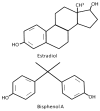The role of Bisphenol A in shaping the brain, epigenome and behavior
- PMID: 21029734
- PMCID: PMC3725332
- DOI: 10.1016/j.yhbeh.2010.10.001
The role of Bisphenol A in shaping the brain, epigenome and behavior
Abstract
Bisphenol A (BPA) is a xenoestrogen that was first synthesized in 1891. Its estrogenic properties were discovered in 1930, and shortly after that chemists identified its usefulness in the production of epoxy resins. Since the 1950s BPA has been used as a synthetic monomer in the manufacturing of polycarbonate plastic, polystyrene resins, and dental sealants. Roughly 6.5 billion pounds of BPA are produced each year and it is the major estrogenic compound that leaches into nearby water and food supplies (vom Saal et al., 2007). BPA has been detected in 95% of human urine samples, which indicates that environmental exposure is widespread (Calafat et al., 2005). Moreover, BPA affects reproductive tissues and the brain. Thus many studies have focused on the effects of BPA during embryonic development. The most recent FDA update (Administration January 2010) points to "some concern about the potential effects of Bisphenol A on the brain, behavior, and prostate gland in fetuses, infants, and young children." In light of this concern, we present an updated review of BPA's action on the brain and behavior. We begin with a discussion of BPA's role as both an endocrine active compound and an agent that alters DNA methylation. Next, we review publications that have reported effects of BPA on brain and behavior. We end with our interpretation of these data and suggestions for future research directions.
Copyright © 2010 Elsevier Inc. All rights reserved.
Figures



References
-
- Administration, U. S. F. a. D. Update on Bisphenol A for Use in Food Contact Applications. Jan, 2010.
-
- Akingbemi BT, Sottas CM, et al. Inhibition of testicular steroidogenesis by the xenoestrogen bisphenol A is associated with reduced pituitary luteinizing hormone secretion and decreased steroidogenic enzyme gene expression in rat Leydig cells. Endocrinology. 2004;145 (2):592–603. - PubMed
Publication types
MeSH terms
Substances
Grants and funding
LinkOut - more resources
Full Text Sources

